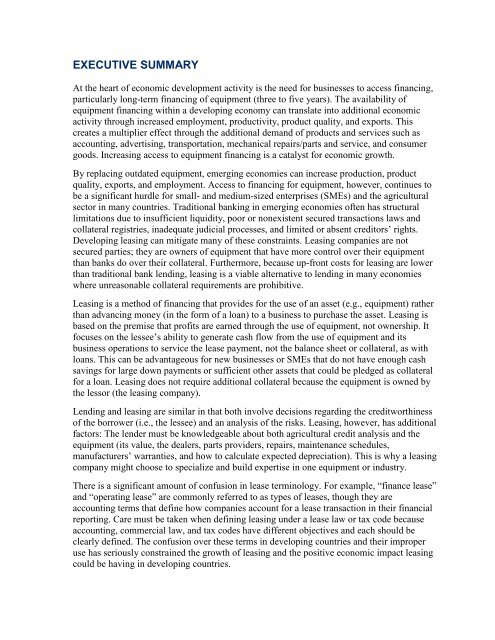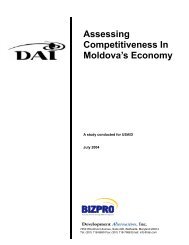Enhancing the Leasing Enabling Environment - Economic Growth ...
Enhancing the Leasing Enabling Environment - Economic Growth ...
Enhancing the Leasing Enabling Environment - Economic Growth ...
Create successful ePaper yourself
Turn your PDF publications into a flip-book with our unique Google optimized e-Paper software.
EXECUTIVE SUMMARY<br />
At <strong>the</strong> heart of economic development activity is <strong>the</strong> need for businesses to access financing,<br />
particularly long-term financing of equipment (three to five years). The availability of<br />
equipment financing within a developing economy can translate into additional economic<br />
activity through increased employment, productivity, product quality, and exports. This<br />
creates a multiplier effect through <strong>the</strong> additional demand of products and services such as<br />
accounting, advertising, transportation, mechanical repairs/parts and service, and consumer<br />
goods. Increasing access to equipment financing is a catalyst for economic growth.<br />
By replacing outdated equipment, emerging economies can increase production, product<br />
quality, exports, and employment. Access to financing for equipment, however, continues to<br />
be a significant hurdle for small- and medium-sized enterprises (SMEs) and <strong>the</strong> agricultural<br />
sector in many countries. Traditional banking in emerging economies often has structural<br />
limitations due to insufficient liquidity, poor or nonexistent secured transactions laws and<br />
collateral registries, inadequate judicial processes, and limited or absent creditors’ rights.<br />
Developing leasing can mitigate many of <strong>the</strong>se constraints. <strong>Leasing</strong> companies are not<br />
secured parties; <strong>the</strong>y are owners of equipment that have more control over <strong>the</strong>ir equipment<br />
than banks do over <strong>the</strong>ir collateral. Fur<strong>the</strong>rmore, because up-front costs for leasing are lower<br />
than traditional bank lending, leasing is a viable alternative to lending in many economies<br />
where unreasonable collateral requirements are prohibitive.<br />
<strong>Leasing</strong> is a method of financing that provides for <strong>the</strong> use of an asset (e.g., equipment) ra<strong>the</strong>r<br />
than advancing money (in <strong>the</strong> form of a loan) to a business to purchase <strong>the</strong> asset. <strong>Leasing</strong> is<br />
based on <strong>the</strong> premise that profits are earned through <strong>the</strong> use of equipment, not ownership. It<br />
focuses on <strong>the</strong> lessee’s ability to generate cash flow from <strong>the</strong> use of equipment and its<br />
business operations to service <strong>the</strong> lease payment, not <strong>the</strong> balance sheet or collateral, as with<br />
loans. This can be advantageous for new businesses or SMEs that do not have enough cash<br />
savings for large down payments or sufficient o<strong>the</strong>r assets that could be pledged as collateral<br />
for a loan. <strong>Leasing</strong> does not require additional collateral because <strong>the</strong> equipment is owned by<br />
<strong>the</strong> lessor (<strong>the</strong> leasing company).<br />
Lending and leasing are similar in that both involve decisions regarding <strong>the</strong> creditworthiness<br />
of <strong>the</strong> borrower (i.e., <strong>the</strong> lessee) and an analysis of <strong>the</strong> risks. <strong>Leasing</strong>, however, has additional<br />
factors: The lender must be knowledgeable about both agricultural credit analysis and <strong>the</strong><br />
equipment (its value, <strong>the</strong> dealers, parts providers, repairs, maintenance schedules,<br />
manufacturers’ warranties, and how to calculate expected depreciation). This is why a leasing<br />
company might choose to specialize and build expertise in one equipment or industry.<br />
There is a significant amount of confusion in lease terminology. For example, ―finance lease‖<br />
and ―operating lease‖ are commonly referred to as types of leases, though <strong>the</strong>y are<br />
accounting terms that define how companies account for a lease transaction in <strong>the</strong>ir financial<br />
reporting. Care must be taken when defining leasing under a lease law or tax code because<br />
accounting, commercial law, and tax codes have different objectives and each should be<br />
clearly defined. The confusion over <strong>the</strong>se terms in developing countries and <strong>the</strong>ir improper<br />
use has seriously constrained <strong>the</strong> growth of leasing and <strong>the</strong> positive economic impact leasing<br />
could be having in developing countries.

















